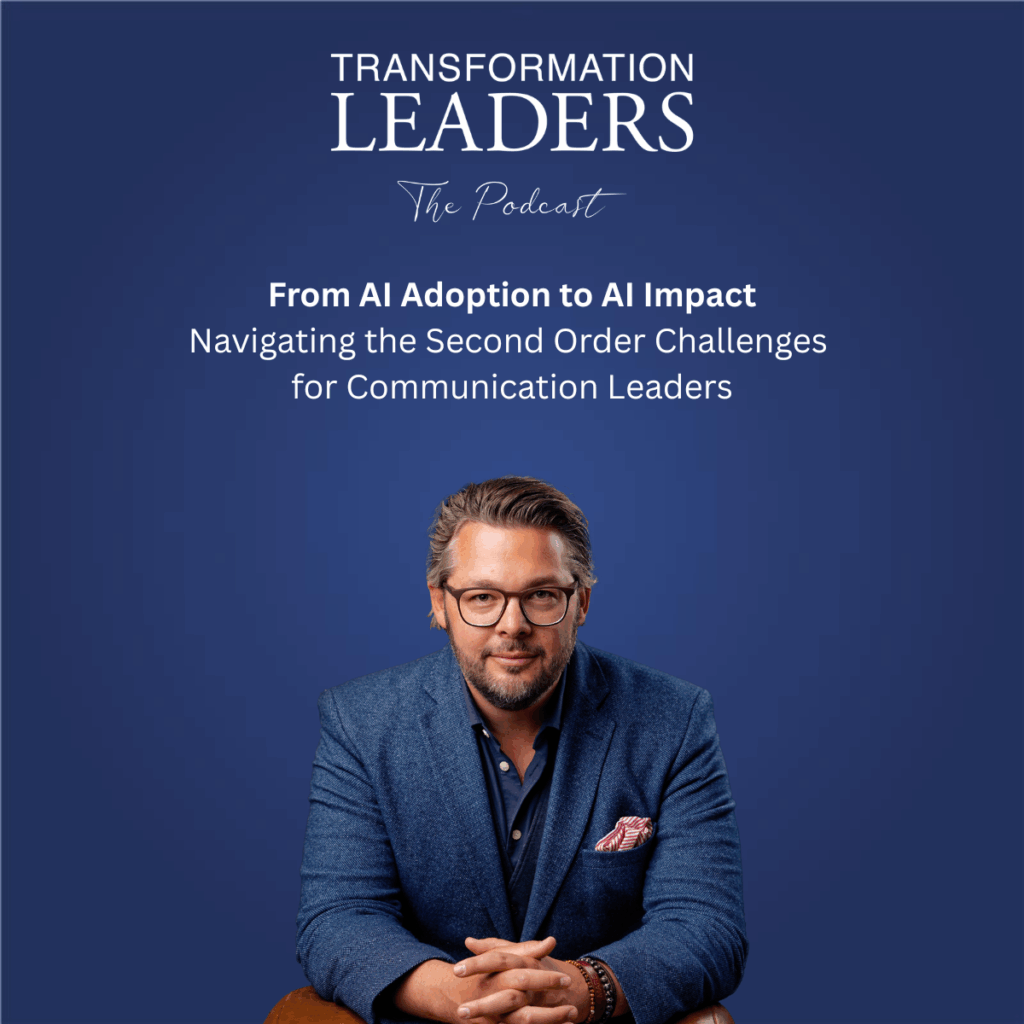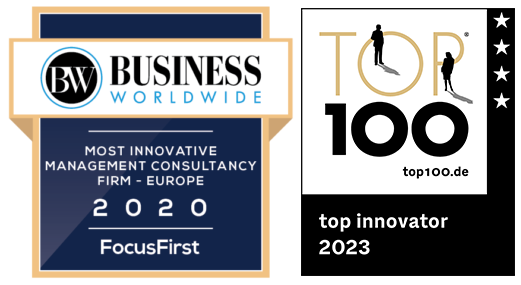From AI Adoption to AI Impact
The Communications Leadership Playbook (2025-2026)SCIENCE-BASED & FIELD-TESTED
Synthesized 2024-2025 from Stanford, Harvard, McKin sey, OECD, OpenAI, and others.
By FocusFirst with technology insights from our AI technology partner Quantineers
Executive Summary
AI adoption has reached 78% across enterprises—yet only 5% achieve transformative impact at scale.
The gap isn’t technical. It’s human.
Organizations that successfully deployed AI tools now face a more complex challenge: orchestrating intelligence as an enterprise capability rather than managing scattered point solutions. This playbook addresses the second-order challenge facing Communications leaders—moving from fragmented tool usage to systematic orchestration across governance, narrative, and leadership.
The Maturity Trap
Widespread tool deployment creates the illusion of transformation while operational capabilities lag behind.
The Governance-Execution Gap
46% of organizations lack structured ROI frameworks; policies exist but controls don’t.
The Orchestration Imperative
Future-built companies achieve 5x revenue gains and 3x cost reductions through systematic integration.

Listen to the special episode
For an in-depth discussion on this topic, listen to the special podcast episode where René Esteban (CEO, Founder of FocusFirst) break down the core concepts from the booklet.
Listen on Spotify | Apple Podcasts | Deezer
From AI Adoption to AI Impact
You’ve proven you can move fast. Now you need to prove you can move the needle.
That’s the quiet pressure every Communications leader feels right now.
Your teams use AI daily. The tools work. Efficiency is up.
But when the CFO asks about business impact, the answer gets complicated.
Because adoption was never the finish line.
It was the starting point for something harder.
The Gap No One Talks About
78% of organizations now use AI actively. Yet only 5% achieve transformative results at scale.
The gap isn’t technical. Stanford, McKinsey, and BCG research confirms it. The barriers are human. Change management. Culture. Leadership alignment. Skill development.
These outrank data quality, tools, or integration as obstacles to impact. Here’s what that looks like in practice. Your team generates content faster. But brand consistency suffers across regions. Your dashboards show usage metrics. But you can’t connect them to strategic outcomes.
Your governance policies exist. But no one knows how to operationalize them in daily workflows. You’ve adopted AI. You haven’t orchestrated it. And that distinction determines whether Communications becomes a strategic integrator or remains a service function.
What Orchestration Actually Means
Orchestration is the shift from deploying tools to governing intelligence as a system. It means every AI-enabled output reinforces your brand. Every workflow embeds compliance by design. Every team member knows not just how to use AI, but when, why, and within what guardrails. It requires three pillars working in concert.
- Governance by Design. Not rulebooks. Guardrails embedded into workflows. Risk-tiered frameworks that enable speed without compromising safety. Automated compliance that flags issues in real time, not after publication.
- Narrative Consistency. Brand-trained models that start from your voice, not generic patterns. Dynamic guidelines that evolve with strategy. Real-time monitoring that catches drift before it reaches stakeholders.
- Adaptive Leadership. Continuous enablement, not one-time training. Transparent communication about impact on roles. Visible commitment from the top that signals this is strategic, not tactical. When these three pillars align, something shifts. AI stops being a productivity tool and becomes an enterprise capability.
The Competitive Reality
The gap between future-built companies and others isn’t narrowing.
It’s widening.
BCG research shows future-built companies achieve five times the revenue increases of peers. Three times the cost reductions.
They allocate 15% of AI budgets to agentic systems while laggards allocate almost none. For Communications leaders, this creates both urgency and opportunity. The urgency: the window for establishing orchestration capabilities is narrowing.
Organizations that master this in 2025-2026 will build advantages that become difficult to overcome. The opportunity: Communications can evolve from executing stakeholder requests to orchestrating enterprise intelligence.
The function that gets this right becomes indispensable. The capability that enables coherent expression at velocity, manages reputational risk in real time, and translates strategy into narrative across global stakeholders.
What Changes When You Get This Right
Leaders who master orchestration report something specific. They stop defending AI investments and start allocating more resources to scale what works. Their teams move from fragmented experimentation to systematic capability building.
Governance shifts from bottleneck to enabler. Brand consistency improves even as content velocity increases.
Most importantly, they translate complexity into measurable outcomes. Faster.
Because they’ve built the operating system that connects AI activity to business impact.
The Path Forward
The transformation from adoption to orchestration requires four strategic actions. Establish a value realization framework that connects AI initiatives to outcomes the C-suite cares about. Not usage metrics. Impact metrics.
Operationalize responsible AI governance. Move policies from documents into workflows. Automate compliance. Create clear accountability structures. Launch continuous enablement programs. Not one-time training.
Ongoing learning systems that build deep AI literacy and adaptive capabilities across your function. Audit and consolidate your technology stack. Eliminate shadow AI. Rationalize around enterprise-grade platforms that ensure security, interoperability, and governance.
None of this is quick. All of it is necessary.
Why This Matters Now
You know the moment when the board asks about AI impact and the answer feels insufficient. When your team is working harder but the strategic value remains unclear.
When you sense that other functions are pulling ahead while Communications stays stuck in execution mode. That moment is the signal.
The work of orchestration isn’t glamorous. It doesn’t generate the excitement of a new tool launch. But it’s what separates organizations that capture transformative value from those trapped in the maturity plateau.
And for Communications leaders willing to embrace this challenge, the opportunity is unprecedented. To position your function as the orchestrator of enterprise intelligence.
The guardian of coherent narrative. A true driver of competitive advantage in the AI era. The time to begin is now.
Ready to Transform Your Organization?
Talk to Us
Schedule a complimentary consultation with one of our senior advisors to discuss your specific challenges.
Book a Keynote
Inspire your team or your entire organization. Contact us to book one of our experts for your next event.
Frankfurt
Neue Mainzer Straße 66-68
6th Floor, Eurotheum
60311 Frankfurt
Germany
Fon +49 69 870 078 740
hello@focusfirst.com
London
Golden Cross House,
8 Duncannon Street, London,
Greater London, WC2N 4JF
United Kingdom
Fon +44 20 3928 8285
hello@focusfirst.co.uk
Singapore
Level 19 & 20, Tower 2,
1 Raffles Place
SINGAPORE, 048616
Singapore
hello@focusfirst.sg
Phone: +65 3105 2005


